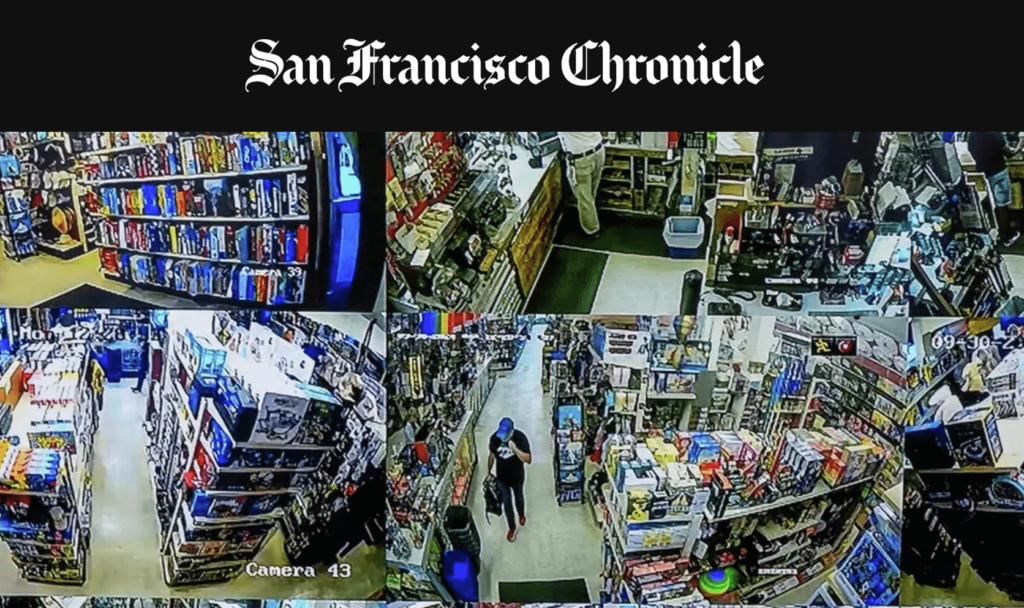This article was originally posted in the San Francisco Chronicle
By Rachel Swan, Danielle Echeverria
Security guards rove the sidewalks near Powell and Ellis streets in San Francisco, an area known for its posh name-brand boutiques and cable cars — and, more recently, its struggles with retail theft.
The guards add a uniformed presence, supplementing an already high concentration of police patrols. But having all those eyes on the street didn’t seem to matter on a recent Wednesday morning, when thieves struck two stores at the intersection.
One filled his backpack at the Skechers shoe store before crossing the street to Urban Outfitters, where a guard scared him off by brandishing a Taser. Minutes later, the guard had to confront a second thief, who set off store alarms with items concealed under his coat.
ters later, the Urban Outfitters guard — who was not authorized to speak to the media — shook his head, his expression resigned. He said he had not bothered calling police. Chasing shoplifters is not a good use of their time, the guard insisted, citing shifts in California law. Until 2010, it was a misdemeanor to steal merchandise worth less than $400. Four years later, voters confirmed a change made by the legislature that raised the threshold to $950 and lightened sentences for several forms of theft or larceny.
That could change after the November election. On the ballot: Prop 36, a high-stakes initiative to reclassify these offenses as felonies if the perpetrator has at least two past convictions for similar crimes, such as burglary, shoplifting or carjacking. If found guilty, a person could face three years in county jail or state prison.
Many merchants in San Francisco’s hardest-hit shopping districts say they welcome the stiffer penalties, even if research suggests the increased threat of incarceration may not hinder shoplifters. By this point, emotions have grown raw. Store workers are weary of confrontations; customers grow aggravated when whole aisles of products are locked behind theft-proof glass. A law that carries harsher punishments seems like a simple solution.
“Right now there are no consequences for (perpetrators’) actions,” said Cee Hayes, a Muni inspector who witnessed the first thief fleeing Skechers with his stuffed backpack Thursday. “And this area,” he said, gesturing to the row of stores with shimmering glass display windows, “this area is impacted a lot.”
Property crimes like shoplifting tend to be underreported, and even data about incidents reported to police can be impacted by intricate factors, including retailers’ own anti-theft measures and their policies on reporting theft. In 2021, for example, a modification to a theft reporting system at a single Target store doubled the city’s monthly shoplifting rate.
Pandemic lockdowns also influenced the numbers. Police records show that incidents declined in San Francisco during the pandemic, before picking back up in 2021 and spiking in 2022. In 2023, the number of reports receded to pre-pandemic levels, but this year, reported incidents are on track to once again surpass the 2019 numbers.
Crime data analyst Jeff Asher found that slower police response times could dissuade people from reporting property crimes, though there is little data available on how often retailers report shoplifting to the police or whether that’s changed over time. Such aberrations make it difficult to reliably measure the amount of shoplifting happening in any given area.
Nevertheless, a Chronicle analysis of police department data on reported shoplifting incidents found the stretch of Powell Street from Market to O’Farrell has been a retail theft hotspot over the past few years. Between January and August of this year, there were nearly 200 reported shoplifting incidents around the two intersections. Business corridors with large grocery or pharmacy chain stores, like Safeway or Walgreens, generally have higher than average reported theft incidents.
These retail hubs have become battlefronts in a heated public safety debate, and could serve as laboratories testing the impact of Prop 36, should it pass in November. Business owners are also deliberating whether the measure will help other beset streets, including intersections in the Castro, Cow Hollow and Civic Center. Viral videos, which purport to illustrate San Francisco’s shoplifting epidemic with scenes of people brazenly shoving items into bags, have only exacerbated the frustrations of merchants, security guards and store clerks.
Supporters of Prop 36, among them a broad coalition of mayors, prosecutors and trade groups, view it as a strong deterrent that will make streets safer and lure shoppers back. Critics, including Gov. Gavin Newsom, question the wisdom and benefit of locking more people up.
Since the passage of Proposition 47 — the 2014 ballot measure that categorized thefts worth less than $950, and some drug offenses, as misdemeanors — jail and prison populations have plummeted, but the effect on crime has been modest, according to a report from the nonpartisan Public Policy Institute of California. Prop 36 would roll back parts of the decade-old law and almost certainly put more people behind bars. Whether it would change conditions on the street is unclear.
San Jose Mayor Matt Mahan, an influential spokesperson for the ballot initiative, believes it will set new norms. If people see swift, consistent repercussions, he said, then surely they will modify their behavior.
“It’s common sense,” Mahan said in an interview. “It sends an important message to Sacramento, and to our criminal justice system, that we need to hold people accountable.” He also highlighted a provision of the measure that mandates treatment for some drug offenses, which Mahan characterized as “compassionate intervention.”
To Tinisch Hollins, an opponent of Prop 36 who runs the reform organization Californians for Safety and Justice, the measure is a shrewd play by politicians and law enforcement trying to ease — or perhaps manipulate — the public’s anxiety over crime.
“It’s really smoke and mirrors,” Hollins said, adding that the measure points to problems without offering real solutions. Longer sentences don’t steer perpetrators away from crime, and tend to be counterproductive, Hollins argued, noting that when people return to society they face barriers finding jobs or housing.
As the discourse intensifies, store employees and small business owners are trying to thwart thieves with their own methods.
Over by 18th and Castro streets — another top area for reported shoplifting incidents — clerks at one adult shop tried to exact justice through public humiliation: They screen-grabbed photos of suspected shoplifters from the store’s surveillance cameras, and placed the pictures in a display case on the counter.
Even that didn’t work, said shop clerks James Smith and Mai Hall. A man captured in one of the photos kept coming in anyway to load gels and sex toys into a cart.
A more tough-on-crime law, with the specter of prison for repeat offenders, would probably help, Smith said.
Wincing, he added, “It’s really wrong to steal from us.”
At a Walgreens store on the corner of 18th and Castro streets, identified by several merchants as the neighborhood’s prime target for theft, a tall security guard stood at the door. His name is Cornelius Ford, and he’s well-attuned to the movements and subterfuge of shoplifters.
The craftier ones pretend to be paying customers, he said, aimlessly perusing aisles as though stalling for time.
Ford confronts them sternly and tries to avoid physical altercations, but he said he immediately calls police if someone gets violent. He would favor a law with stricter jail sentences.
“Of course,” Ford said, without hesitation. “Who gave them the right to just take things?”
Some business owners tried to be circumspect. Terry Asten Bennett, co-owner of Cliff’s Variety — a hardware and knick-knack shop on Castro with pinwheels and big Halloween displays in front — said Prop 36 could be “a good start,” though she would also like to see faster response times from police.
“We’ve got 48 cameras — eyes all over the store,” said Asten Bennett, who also serves as president of the Castro Merchants Association.
“My office manager should work for the FBI,” she added, praising her staff’s ability to scan surveillance footage to find repeat shoplifters.
Alvin Orloff, who owns Fabulosa Books next door, said he had no opinion on Prop 36. If thieves are roaming the Castro, they show little interest in his snug bookshop, where the shelves brim with classic paperbacks and obscure titles.
Still, Orloff and his employees can peer out the window and see people ransacking the Walgreens across the street.
“I’m on the outside looking at that,” Orloff said. He’s not convinced, however, that a ballot measure to “double down on law and order” will achieve anything.

